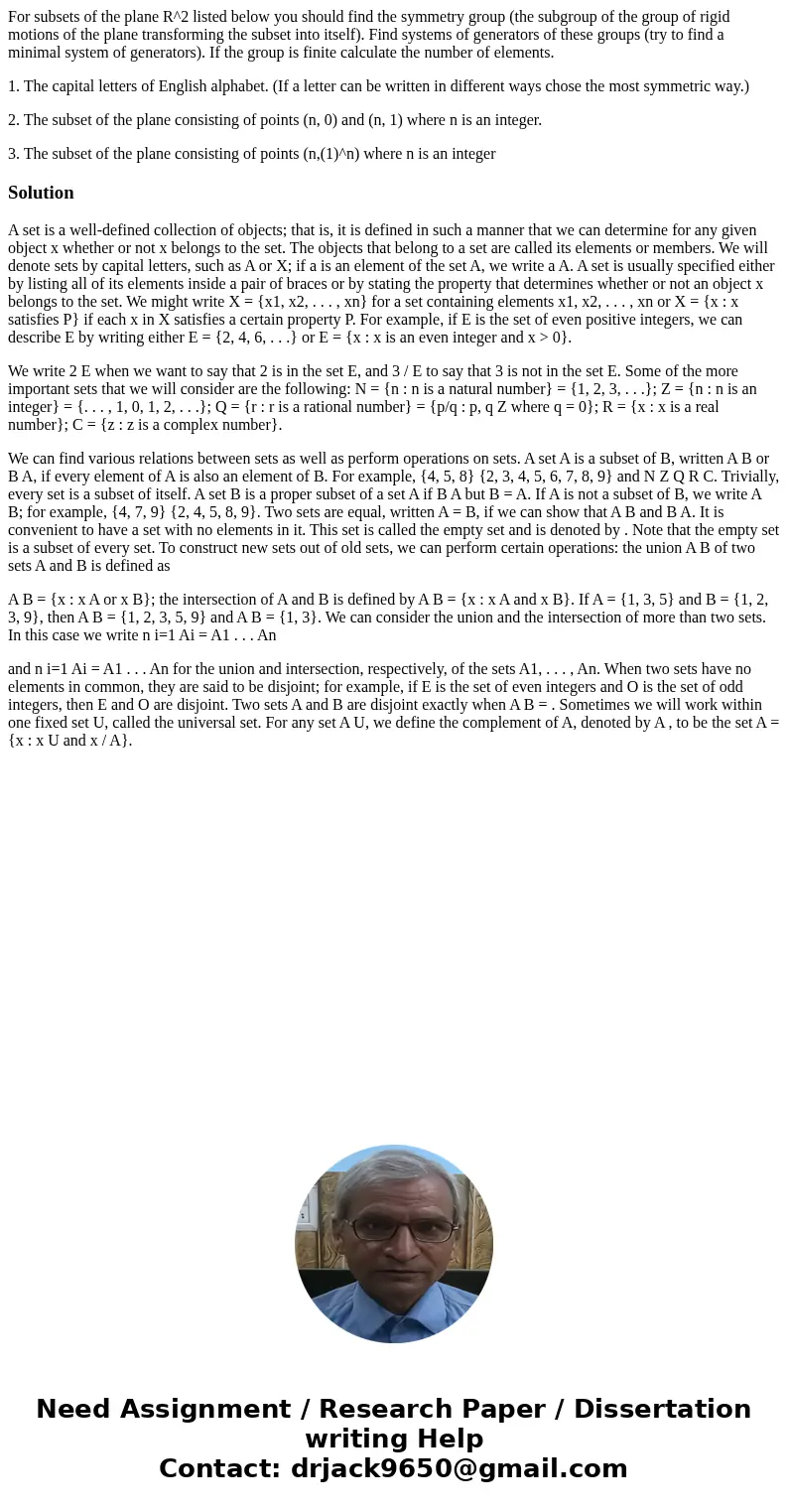For subsets of the plane R2 listed below you should find the
For subsets of the plane R^2 listed below you should find the symmetry group (the subgroup of the group of rigid motions of the plane transforming the subset into itself). Find systems of generators of these groups (try to find a minimal system of generators). If the group is finite calculate the number of elements.
1. The capital letters of English alphabet. (If a letter can be written in different ways chose the most symmetric way.)
2. The subset of the plane consisting of points (n, 0) and (n, 1) where n is an integer.
3. The subset of the plane consisting of points (n,(1)^n) where n is an integer
Solution
A set is a well-defined collection of objects; that is, it is defined in such a manner that we can determine for any given object x whether or not x belongs to the set. The objects that belong to a set are called its elements or members. We will denote sets by capital letters, such as A or X; if a is an element of the set A, we write a A. A set is usually specified either by listing all of its elements inside a pair of braces or by stating the property that determines whether or not an object x belongs to the set. We might write X = {x1, x2, . . . , xn} for a set containing elements x1, x2, . . . , xn or X = {x : x satisfies P} if each x in X satisfies a certain property P. For example, if E is the set of even positive integers, we can describe E by writing either E = {2, 4, 6, . . .} or E = {x : x is an even integer and x > 0}.
We write 2 E when we want to say that 2 is in the set E, and 3 / E to say that 3 is not in the set E. Some of the more important sets that we will consider are the following: N = {n : n is a natural number} = {1, 2, 3, . . .}; Z = {n : n is an integer} = {. . . , 1, 0, 1, 2, . . .}; Q = {r : r is a rational number} = {p/q : p, q Z where q = 0}; R = {x : x is a real number}; C = {z : z is a complex number}.
We can find various relations between sets as well as perform operations on sets. A set A is a subset of B, written A B or B A, if every element of A is also an element of B. For example, {4, 5, 8} {2, 3, 4, 5, 6, 7, 8, 9} and N Z Q R C. Trivially, every set is a subset of itself. A set B is a proper subset of a set A if B A but B = A. If A is not a subset of B, we write A B; for example, {4, 7, 9} {2, 4, 5, 8, 9}. Two sets are equal, written A = B, if we can show that A B and B A. It is convenient to have a set with no elements in it. This set is called the empty set and is denoted by . Note that the empty set is a subset of every set. To construct new sets out of old sets, we can perform certain operations: the union A B of two sets A and B is defined as
A B = {x : x A or x B}; the intersection of A and B is defined by A B = {x : x A and x B}. If A = {1, 3, 5} and B = {1, 2, 3, 9}, then A B = {1, 2, 3, 5, 9} and A B = {1, 3}. We can consider the union and the intersection of more than two sets. In this case we write n i=1 Ai = A1 . . . An
and n i=1 Ai = A1 . . . An for the union and intersection, respectively, of the sets A1, . . . , An. When two sets have no elements in common, they are said to be disjoint; for example, if E is the set of even integers and O is the set of odd integers, then E and O are disjoint. Two sets A and B are disjoint exactly when A B = . Sometimes we will work within one fixed set U, called the universal set. For any set A U, we define the complement of A, denoted by A , to be the set A = {x : x U and x / A}.

 Homework Sourse
Homework Sourse